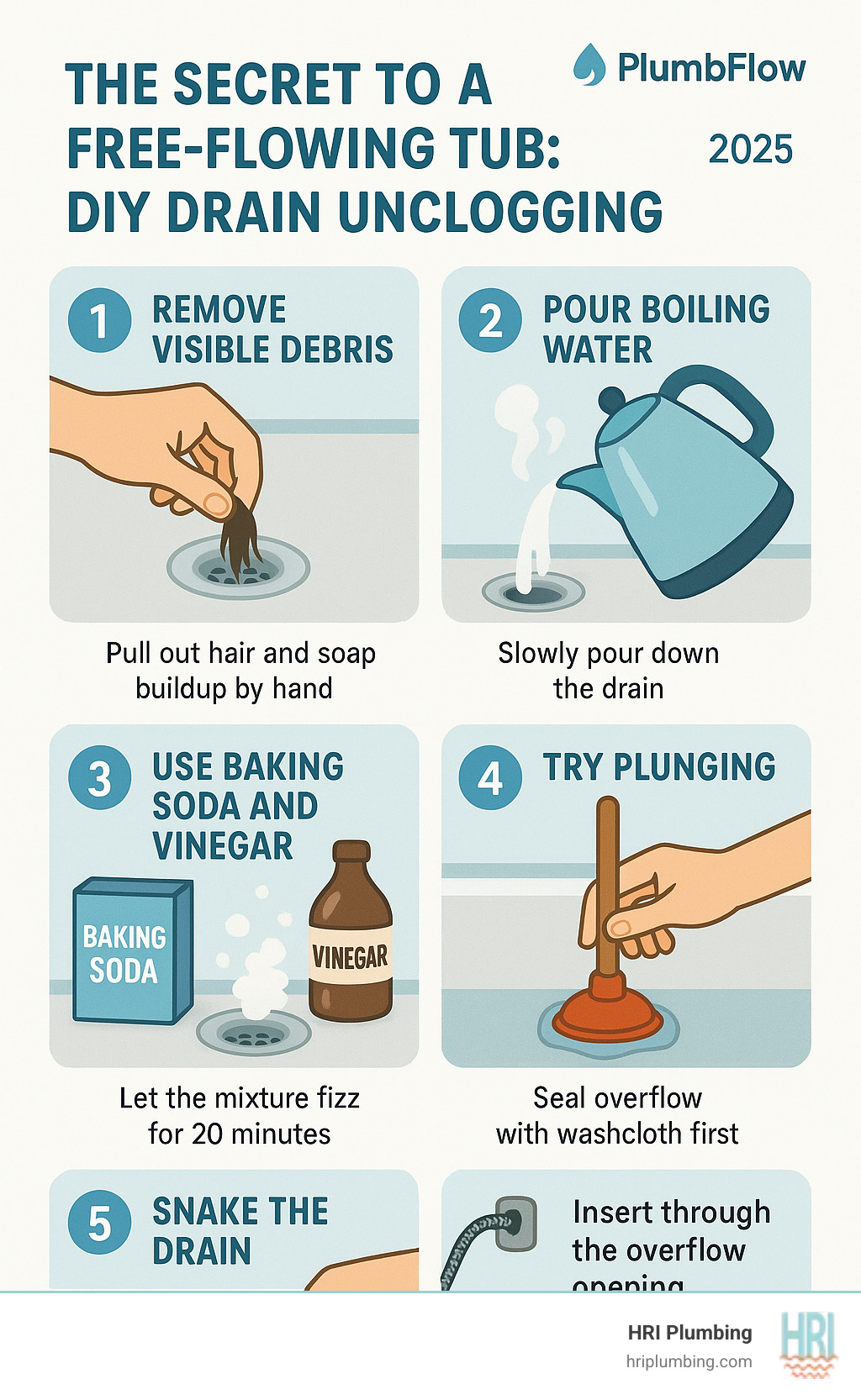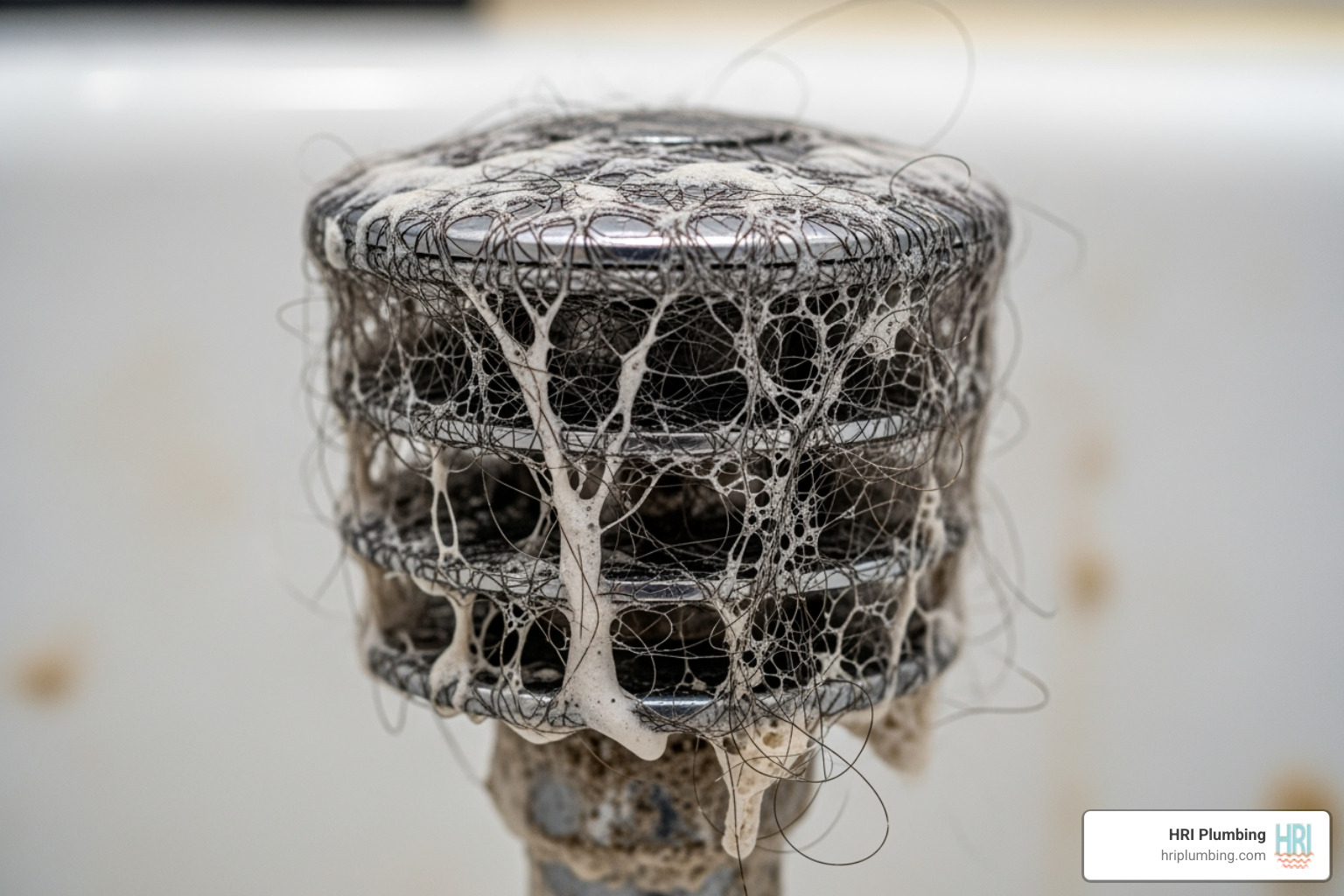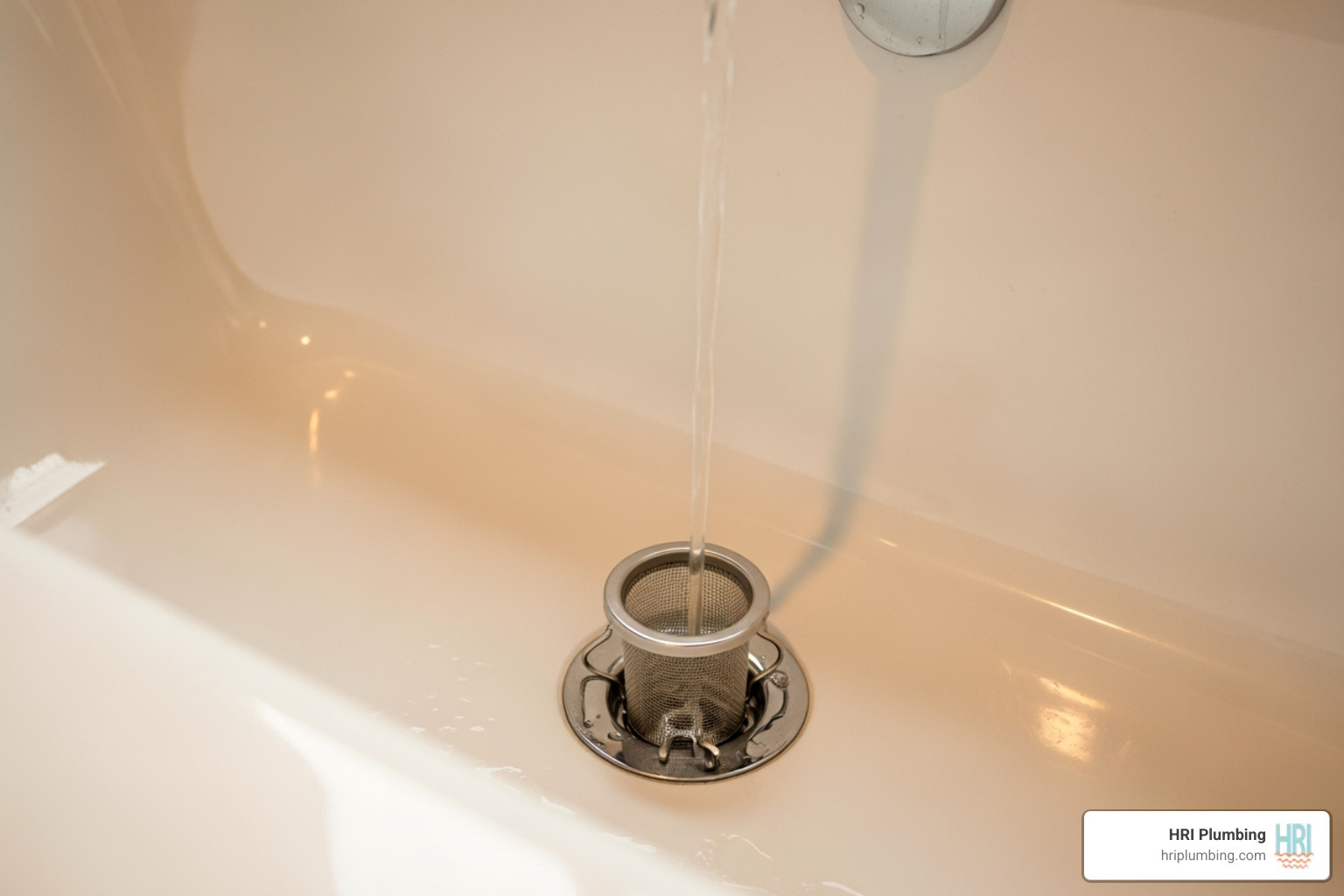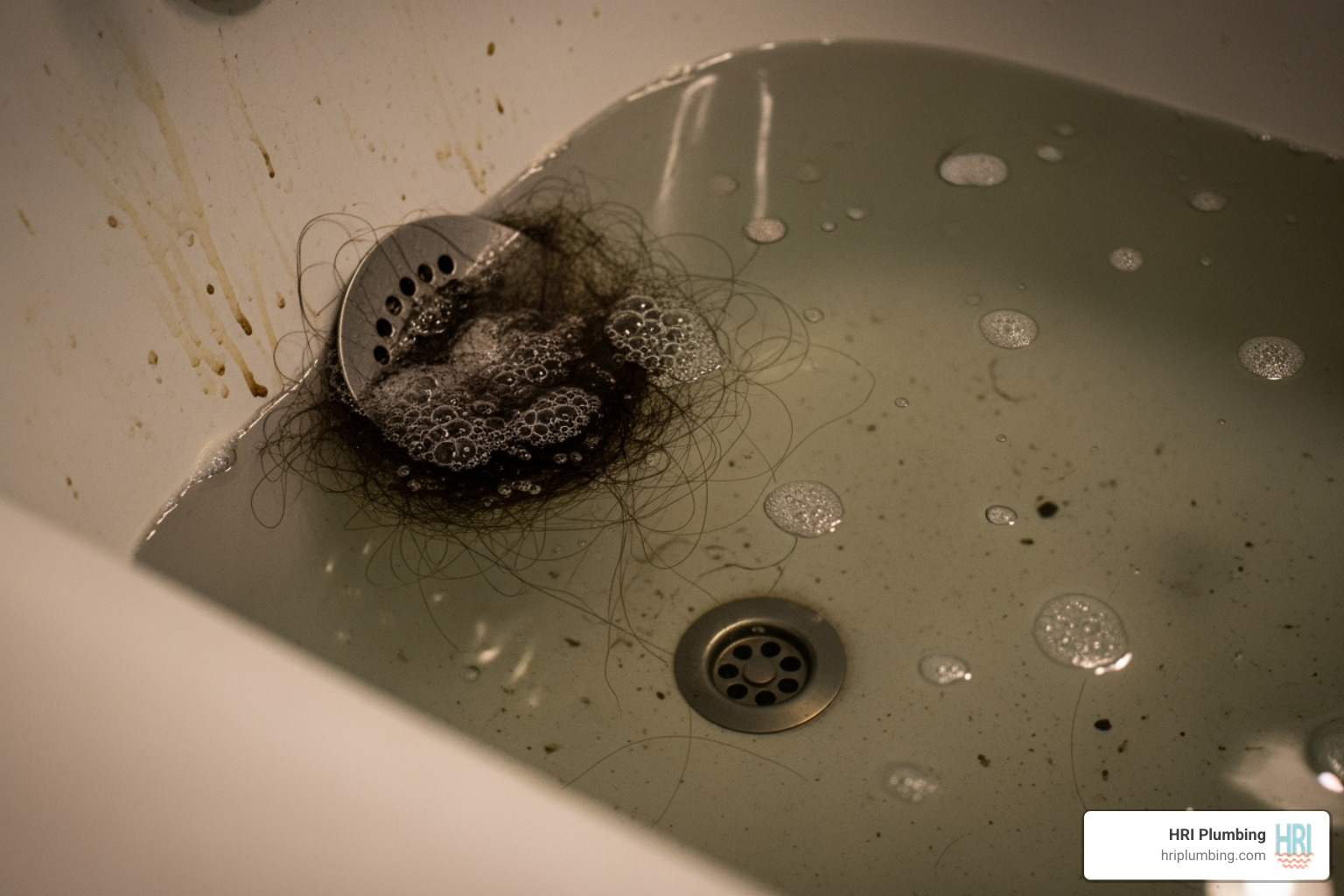Why Bathtub Drain Clog Issues Demand Immediate Action
A bathtub drain clog can turn your relaxing shower into a frustrating ankle-deep puddle experience. You roll out of bed ready for a refreshing shower to start your day, but as you lather up, you realize water is creeping up around your ankles.
Quick Solutions for Bathtub Drain Clogs:
- Remove visible debris - Pull out hair and soap buildup by hand
- Pour boiling water slowly down the drain to dissolve soap scum
- Use baking soda and vinegar - 1/2 cup each, wait 20 minutes, flush with hot water
- Try plunging - Seal overflow drain with washcloth first
- Snake the drain - Insert through overflow opening for deeper clogs
The good news? Most bathtub drain clogs are caused by hair and soap scum buildup - problems you can tackle yourself with common household items. Hair is the most likely culprit, especially if someone in your household has long hair.
Don't reach for harsh chemical drain cleaners just yet. These can damage your pipes and harm the environment. Instead, natural methods and simple tools often work just as well - and they're safer for your family and plumbing system.
When to call a professional: If multiple drains are backing up, you smell sewage, or DIY methods fail after several attempts.

Understanding the Telltale Signs and Common Culprits
Nobody wants to deal with a bathtub drain clog, but knowing what to look for can help you catch the problem before it turns into a full-blown plumbing emergency. Think of these warning signs as your drain's way of asking for help!
Signs Your Drain Needs Attention
Your bathtub drain has a few ways of telling you it's struggling. Water pooling around your feet during a shower is the most obvious red flag - what should be a quick rinse turns into standing in a mini lake.
But there are subtler hints too. If draining takes several minutes after your shower instead of disappearing quickly, your drain is working overtime to push water through a narrowing passage. It's like trying to drink a thick milkshake through a skinny straw.
Unpleasant smells wafting up from your drain are another dead giveaway. That funky odor happens when bacteria feast on the hair and soap buildup trapped in your pipes, creating hydrogen sulfide gas. Not exactly the aromatherapy experience you were hoping for!
Strange gurgling sounds coming from the drain mean air is getting trapped and struggling to escape around a blockage. Your drain is literally trying to tell you something's wrong. And if you can spot visible debris like hair clumps or soap scum around the drain opening, you're seeing just the tip of the iceberg.
Why Your Bathtub Drain is Clogged
Most bathtub drain clogs happen because a few troublemakers team up to create the perfect storm. Hair buildup is the biggest villain here - every shower sends loose strands down the drain, where they tangle together like a net catching everything else that follows.
Soap scum acts like the glue in this messy equation. All those shampoos, conditioners, and body washes leave behind a sticky residue that binds with hair and creates stubborn clumps. It's basically nature's worst arts and crafts project happening in your pipes.
If you live in an area with hard water minerals, you've got an extra challenge. Calcium and magnesium deposits slowly coat your pipes, making them narrower and rougher - perfect for snagging debris. It's like having velcro lining your drain.
Sometimes small objects take an unexpected dive down the drain too. Jewelry, bottle caps, or pieces of broken soap can create instant blockages or give other debris something to stick to.
In older homes, pipe corrosion can make the problem worse by creating rough, uneven surfaces that grab onto every piece of hair and soap scum that passes by.
The good news? Most of these issues are totally manageable with the right approach. At HRI Plumbing, we handle these situations regularly through our Drain Cleaning services throughout Jacksonville, Springfield, and the surrounding areas.

Step-by-Step Guide to Clearing a Bathtub Drain Clog
Now comes the fun part – actually tackling that stubborn bathtub drain clog! Think of this as your personal plumbing trip, where you get to be the hero who saves the day (and your morning shower routine).
We'll start with the gentlest approach and gradually work our way up to more serious methods. It's like dating – you don't propose on the first date, and you don't start with a drain snake when a simple hair pull might do the trick.

Safety first! Always wear gloves when dealing with drain clogs. Trust me, you don't want to find what's been lurking down there with your bare hands. It's not pretty, and it definitely doesn't smell like roses.
Essential Tools and Prep Work
Before we dive in, let's gather our drain-fighting toolkit. Having everything ready makes the whole process smoother and keeps you from running around the house looking for supplies while water pools around your ankles.
You'll need rubber gloves to protect your hands from the inevitable gunk fest. A screwdriver and pliers will help you remove different types of drain stoppers – some twist, some lift, and some seem to have a mind of their own. Keep a bucket handy for catching standing water and the lovely debris you'll be pulling out.
A good plunger is worth its weight in gold. Look for one with a flange (that little cup at the bottom) for better sealing power. Baking soda and white vinegar are your natural cleaning dream team, while boiling water works wonders on soap scum – though here's a crucial tip: only use boiling water if you have metal pipes. If your pipes are plastic (PVC), stick to very hot tap water instead, or you might end up with warped pipes and a much bigger problem.
For the really stubborn clogs, a drain snake is your secret weapon. It's basically a long, flexible cable that reaches deep into your pipes to grab or break up whatever's causing trouble.
Getting started means removing that drain stopper first. Many simply pull straight out, while others need a twist or a screwdriver. Once it's out, take a peek – you might spot your culprit right away!
Put on those gloves and clear any visible gunk with your fingers, pliers, or a bent coat hanger. You'd be amazed what accumulates down there – hair balls that could rival a small pet, soap chunks, and mysterious debris that defies identification. Toss everything in the trash, not back down the drain.
Initial Steps for a Minor Bathtub Drain Clog
If your initial cleanup didn't solve the problem, don't worry. We're just getting started, and these gentle methods often work like magic on everyday clogs.
Manual removal can go deeper than you might think. A drain stick or "Zip-It" tool (a plastic strip with tiny barbs) works great for snagging hair clogs. Gently push it down, twist to catch debris, then slowly pull it out. It's gross but oddly satisfying when you see what comes up.
The boiling water flush is beautifully simple and surprisingly effective. Boil a full pot of water and pour it slowly down the drain in stages. Pour a little, wait a few minutes for the heat to work its magic on soap scum and grease, then pour more. This gradual approach gives the hot water time to dissolve buildup rather than just pushing it around.
Here's where things get fun – the baking soda and vinegar method is like conducting a science experiment in your bathroom. Pour about half a cup of baking soda directly down the drain, then immediately follow with half a cup of white vinegar. Quickly cover the drain with a stopper or wet rag to contain the reaction.
You'll hear satisfying fizzing and bubbling as the acid and base create carbon dioxide gas. This reaction breaks down organic matter, soap scum, and other gunk. Let it sit for 15-20 minutes (or overnight for really stubborn clogs), then flush with hot water. If you're curious about the science behind the reaction, it's actually pretty fascinating stuff.
Avoid chemical cleaners at all costs. Those harsh drain cleaners can damage your pipes, create toxic fumes, and often don't even work on severe clogs. Plus, if you eventually need to call a plumber, mixing chemicals can be dangerous. Natural methods are safer, cheaper, and often more effective.
Advanced Solutions for a Stubborn Bathtub Drain Clog
When gentle methods don't cut it, it's time to bring out the heavy artillery. Don't lose hope – even the most stubborn bathtub drain clogs usually surrender to these techniques.
Plunging isn't just for toilets. It can create enough pressure and suction to dislodge many clogs. Start by removing most standing water, leaving just enough to cover the plunger cup for a good seal.
Here's the crucial step most people miss: seal the overflow drain with a wet washcloth or duct tape. Without this, you're just pushing air around instead of creating pressure on the clog. It's like trying to drink a milkshake through a straw with holes in it – not very effective.
Place the plunger firmly over the drain and give it 10-20 strong, rapid thrusts. Don't just push down – pull up sharply too. The suction can be just as effective as the pressure. Pull the plunger off quickly and listen for that satisfying gurgling sound of water starting to drain.
When all else fails, it's drain snake time. This flexible tool reaches deep into pipes to grab or break up clogs that other methods can't touch. For bathtubs, you'll often get better results by removing the overflow plate and snaking through that opening – it provides a straighter path to the problem area.
Feed the snake gently into the opening until you feel resistance. Once you hit the clog, tighten the thumbscrew and turn the crank clockwise to embed the tip into the blockage or break it apart. When you feel it's hooked or broken up, reverse direction and slowly pull the snake back out, hopefully bringing the clog with it.
Run hot water for several minutes afterward to flush away any remaining debris. It's incredibly satisfying when you see that water flowing freely again. This method is particularly effective for hair and soap scum combinations that create those really stubborn blockages.
If you're interested in learning more about professional techniques, check out how Drain Snaking Helps Clear Blockages. For residents in our service area, we also offer expert Drain Snaking Springfield IL services when DIY methods aren't enough.
How to Prevent Future Clogs
Congratulations, you've conquered that stubborn bathtub drain clog! Now comes the fun part – keeping those drains happy and free-flowing so you never have to deal with ankle-deep shower puddles again. Think of it as giving your plumbing system a little TLC to prevent future headaches.
The secret to avoiding future clogs isn't complicated or expensive. It's all about creating simple habits and investing in a few inexpensive tools that act as your drain's best friends. A little prevention now saves you from a lot of frustration later!

Install a Drain Cover or Hair Catcher
This simple addition is like having a security guard for your drain – it stops troublemakers before they can cause problems. Since hair is the biggest culprit behind most bathtub drain clogs, catching it before it goes down the drain is a game-changer.
Mesh screens are your most affordable option. These little wire or plastic guards sit right over your drain opening, catching hair and soap chunks before they can start their mischievous journey into your pipes. You can find them at any hardware store for just a few dollars.
Silicone stoppers with built-in hair catchers are another fantastic choice. They replace your existing drain stopper and do double duty – they can stop water when you want a bath, and they catch debris when you're showering. The flexible silicone material makes them easy to clean and long-lasting.
The best part? These devices are incredibly easy to clean. Just lift them out after each shower, pull off the collected hair (yes, you'll be amazed at how much there is!), give them a quick rinse, and pop them back in place. It takes about ten seconds and prevents the main cause of drain headaches.
Here's a pro tip that costs nothing: brush your hair before showering. This simple habit removes loose strands before they have a chance to wash down the drain. Your pipes will thank you!
Perform Regular Drain Maintenance
Even with the best hair catcher, some soap residue, body oils, and tiny particles will still make their way past your defenses. Regular maintenance keeps these small amounts from building up into big problems. Think of it as a monthly spa treatment for your pipes!
Monthly flushing with very hot water works wonders for dissolving soap scum and oils before they can harden into stubborn blockages. Once a week, pour a kettle of hot water down the drain – just make sure you have metal pipes, not plastic ones that could warp from the heat.
The baking soda and vinegar treatment we used to clear your clog also makes an excellent monthly preventative measure. That satisfying fizzing action breaks down minor buildup and keeps your drains smelling fresh. It's like giving your pipes a gentle, natural cleaning that won't harm the environment or your plumbing.
Avoiding oily products down the drain is crucial too. Bath oils, body butters, and anything greasy can solidify in your pipes and create nasty blockages. These substances might seem harmless when they're warm, but they turn into pipe-clogging nightmares as they cool down.
Don't forget to regularly clean your drain stoppers and overflow covers themselves. Hair and soap scum love to collect on these fixtures, and cleaning them prevents buildup from eventually washing into your main drain.
Understanding when Do Your Drains Need to Be Cleaned? helps you stay ahead of potential problems. These small, consistent steps make a huge difference in keeping your Jacksonville, Springfield, or Rushville home's plumbing flowing smoothly.
When DIY Isn't Enough: Calling a Professional
We've explored a wide array of DIY solutions, and honestly, you should feel pretty proud of yourself right now! For most bathtub drain clog situations, these home remedies work like a charm. But let's be real – sometimes that stubborn clog just won't budge, no matter how much elbow grease you put into it.
There comes a point where continuing to battle a clog yourself might actually do more harm than good. Knowing when to wave the white flag and call in the professionals isn't giving up – it's being smart about protecting your home and your plumbing system.
Think of it this way: you wouldn't try to perform surgery on yourself, right? Sometimes plumbing problems need that same level of professional expertise. Persistent clogs that keep coming back, multiple fixtures acting up at once, or suspected pipe damage are all clear signs it's time to pick up the phone.
The good news is that professional plumbers have tools and techniques that go way beyond what's available to us DIY warriors. We're talking about high-powered drain cleaning equipment, video camera inspections that can actually see inside your pipes, and years of experience dealing with every weird clog scenario imaginable.
Signs of a Deeper Plumbing Problem
So how do you know when your bathtub drain clog is actually part of a bigger plumbing mystery? Here are the red flags that should have you reaching for your phone instead of your plunger.
All drains are acting sluggish – this is the big one. When your bathtub, bathroom sink, and maybe even your kitchen sink are all draining slowly, you're not dealing with a simple hair clog anymore. This usually means there's a blockage in your main sewer line, which is definitely not a DIY project.
Toilets are backing up too – if your toilet starts gurgling when you drain the bathtub, or worse, backing up entirely, that's your plumbing system crying for professional help. These fixtures share the same main drain line, and when that gets blocked, it affects everything.
You smell sewage or rotten eggs – a persistent, foul odor coming from your drains isn't just unpleasant, it can actually be dangerous. This smell often indicates a serious issue with your sewer line or vent pipes that needs immediate attention.
DIY methods fail repeatedly – you've tried everything in our guide, maybe even twice, and that clog keeps coming back like a bad horror movie sequel. This persistence usually means the blockage is deeper than your tools can reach, or it's made up of something more stubborn than hair and soap scum.
Water is backing up into other fixtures – if running water in your bathtub causes your toilet to bubble, or your sink gurgles when you flush, these are classic signs of a shared blockage in your main line. Your plumbing is basically trying to tell you it's overwhelmed!
You see black, sludgy material coming up from your drain – this is a serious health hazard that requires immediate professional attention. Don't mess around with this one.
Our team at HRI Plumbing has seen it all, from massive hairballs that would make a barber faint to tree roots that somehow found their way into pipes. We use professional-grade equipment and techniques that can tackle even the most challenging situations. Our Expert Drain Cleaning Services are designed to get to the root of the problem, not just treat the symptoms.
We take pride in How We Handle Stubborn Clogged Drains and providing honest, reliable solutions for our neighbors in Jacksonville, Springfield, and Rushville. Sometimes the best DIY decision is knowing when to call in the pros!
Conclusion
There's something deeply satisfying about conquering a bathtub drain clog with your own two hands. We hope this guide has transformed you from someone standing ankle-deep in sudsy water to a confident DIY drain-clearing champion!
You now have an arsenal of techniques at your disposal. Whether it's the simple satisfaction of pulling out a gnarly hairball by hand, watching the fizzing magic of baking soda and vinegar work its chemistry, or feeling that victorious moment when your plunger finally breaks through - these skills will serve you well.
The real secret to avoiding future drain drama lies in those simple preventative habits we discussed. Installing a hair catcher is like having a tiny bouncer for your drain, and those monthly baking soda treatments are basically spa days for your pipes. A little effort now truly saves you from those frustrating morning shower surprises later.
But here's the thing - knowing when to wave the white flag is just as important as knowing how to fight the good fight. Some clogs are simply beyond what household tools can handle, and that's perfectly okay! When you're dealing with persistent clogs, multiple backed-up fixtures, or that telltale sewage smell, it's time to call in the professionals.
At HRI Plumbing, we've seen it all - from massive hairballs that would make your cat jealous to tree roots that somehow found their way into pipes. Our team brings professional-grade equipment and years of experience to tackle even the most stubborn blockages. We're not just fixing the immediate problem; we're diagnosing the root cause to prevent future headaches.
There's no shame in calling for backup. Sometimes the most DIY thing you can do is recognize when a job needs professional expertise. We're here 24/7 because plumbing problems don't follow business hours, and we believe in honest, straightforward service for our neighbors in Jacksonville, Springfield, and Rushville.
For persistent clogs or professional drain cleaning in Rochester, IL, contact our expert team today! We're here to ensure your plumbing flows as smoothly as your day should.












